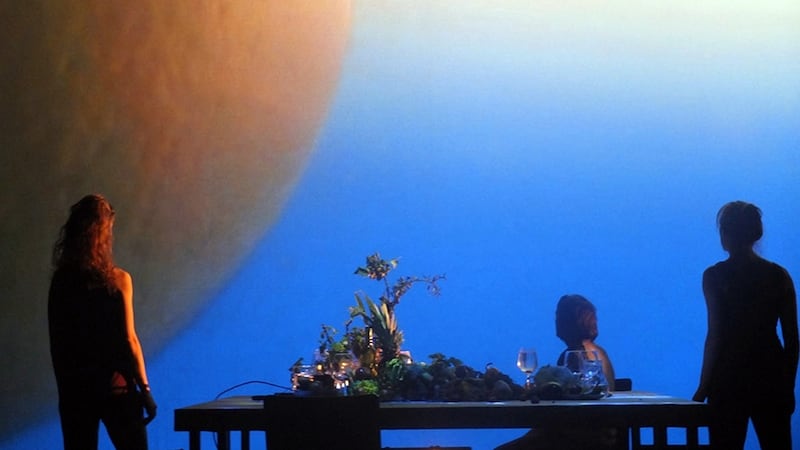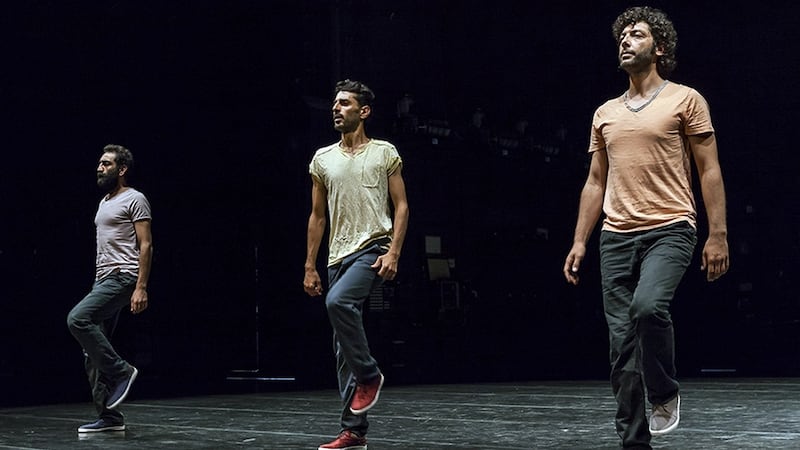The concluding days of this year’s Dublin Dance Festival brought into focus themes that had peeked through earlier performances: in a world of where trust in truthful speech is slowly decaying, how much truth resides in the body? Can our bodies, whether on stage or in the street, offer more veracity? And can bodies provide new perspectives and ways of learning about our changing world?
Artistic director Benjamin Perchet seems to think so. He assembled a programme that asserted dance as a significant mediator for ideas, offering both complementary or contradictory viewpoints. Equally importantly, the programme dumped preconceptions about what exactly defines dance.
Striptease ★★★★
Project Arts Centre, Space Upstairs
Pere Faura's Striptease had little movement, but a lot of talking. Copying footage of Demi Moore in Striptease, he recreated her performance live and then revelled in a spoken postmodernist analysis of striptease.
Faura is an utterly charming performer and carried off the gloomy threat of a lecture with aplomb and humour. At the heart of Striptease is an Irish-tinted question: how do you tell the dancer from the dance? Since the act is predefined - the performer is going to take off his or her clothes - the anticipation of the imagined is more important than the reality.
So separating the dancer from the dance, Faura suggests, depends on the eye of the beholder. Individual preference dictates whether one looks at the body or the striptease movement, a choice that defines each viewer. He illustrates this conclusion by showing video footage of audience reaction to his initial striptease, recorded just minutes beforehand.
Valuing conceptual distance rather than the reality of the intimate was challenged throughout the festival, not just in heady speech, but in witnessing bones, muscles and tendons. How do we experience art and the world around us? Do we anticipate the imagined more than experience the real?
In a world of alternative facts and fake news, when speech has been dumbed down and hope is gutted through campaign promise lies, what deeper analysis can the body offer?
Extraterrestrial Events ★★★★
Samuel Beckett Theatre
This difference between perception and preconception is at the heart of the impressive Extraterrestrial Events, based on real-life accounts of UFO sighting reported to the French Space Agency CNES. Choreographer Philip Connaughton casts soprano Kim Sheehan as the witness to a sighting, her report sung through composer Michael Gallen's stuttering and uncertain phrases.

It’s an account full of alien clichés, like saucer-shaped spacecrafts, gelatinous aliens and bright lights. Seated beside her, Connaughton is a dismissive listener, fidgeting and harumphing throughout, while four dancers - Zoé Bernabéu, Kevin Coquelard, Lucia Kickham and Ryan O’Neill - find physical expression to her emotions and narrative.
The extremes between Sheehan’s sincerity and Connaughton’s aggressive indifference funnels the viewer into a middle ground. In this place lies a grey area, a quasi-reality between her perception and his preconception. Who do we trust? The emotive woman or rational man? Sheehan gives a one-person verbal account, something to be questioned without evidence.
But Extraterrestrial Events suggest that authenticity can be found somewhere in between and that definite truth is elusive and never lies in extremes. Connaughton even adds a further fascinating layer in his role of creator and performer. At a macro level, if he is dismissive of Sheehan's account as a performer, could he also be dismissive of it as a creator? Can the audience believe anything about his creation?
Deep Dish ★★★
Abbey Theatre, on the Abbey stage
There are no grey areas in Deep Dish, an overblown parable on ecological disaster that uses live projections of a dinner party table laden with fruit and vegetables to highlight excessive consumption, middle class apathy and general lip service to environment.

Four performers dine on an over-abundant table while annoyingly bemoaning the excesses of society. One has a secret that can't be revealed by if she did it would blow our minds - a suggestion of eco-doom - while another talks admiringly about a Norwegian seed bank. Projections were always fascinating in a Honey I Shrunk The Kids kind of way, but, within the excess, rhetoric overpowered subtlety.
Displacement ★★★
Abbey Theatre, on the Peacock stage
There was a far more frugal presentation by Syrian-born now French-based choreographer Mithkal Alzghair, whose work Displacement investigated the experience of forced migration on the body. The body may be a repository for our life experience, but how can these possibly come together to create a fixed identity?

Alghair suggests that although in body terms, the past is ourselves, our identity remains fluid. Different aspects of our past are embodied and often supressed, but emerge and re-emerge at different points of our lives.
Displacement depicts this through two constant movements: one for the feet and the other for the arms. Beginning alone, later joined by Rami Farah and Samil Taskin, Alzghair's feet are never still. Every movement fits into a constant pulse, whether tiny steps on-the-spot or lurching movements derived from Syrian folk dance.
In contrast, when the three raise their arms, palms forward, they suggest exposure and vulnerability, but also invitation or an appeal to stop. Overall, the dance feels like a constant journey that unravels in the last few moments when the three performers take single uncertain steps into the darkness. It doesn’t feel like a destination has been reached, rather a weary compromise has been made in reconciling the past with the present.
The individual artist’s voice seemed louder and clearer in this year’s festival. Not just to entertain, but to challenge thinking at an individual and societal level.










